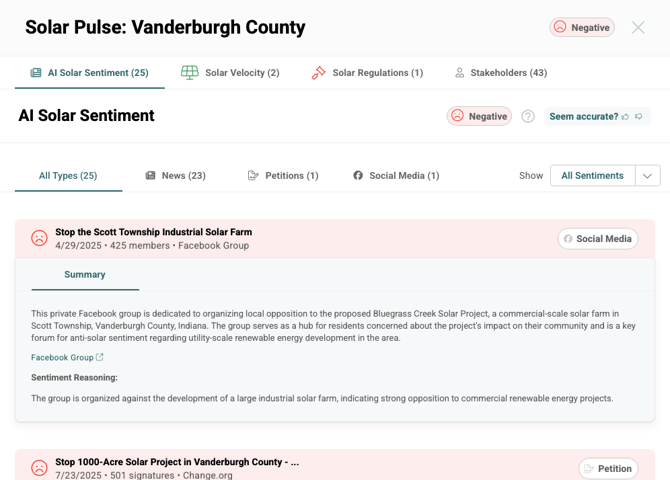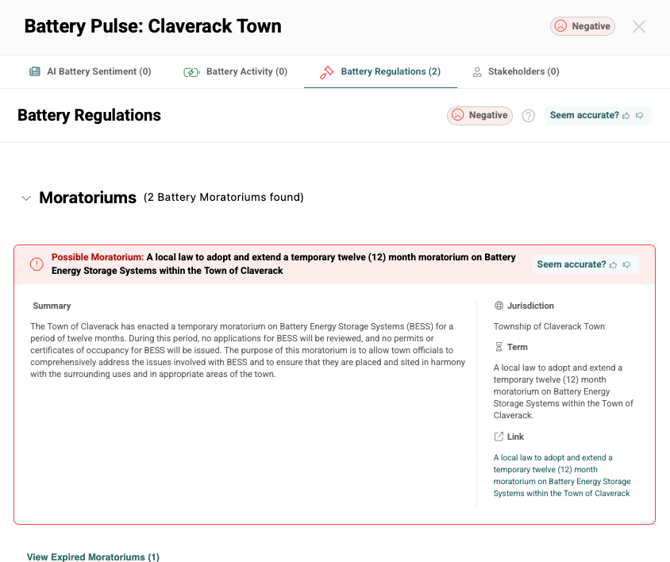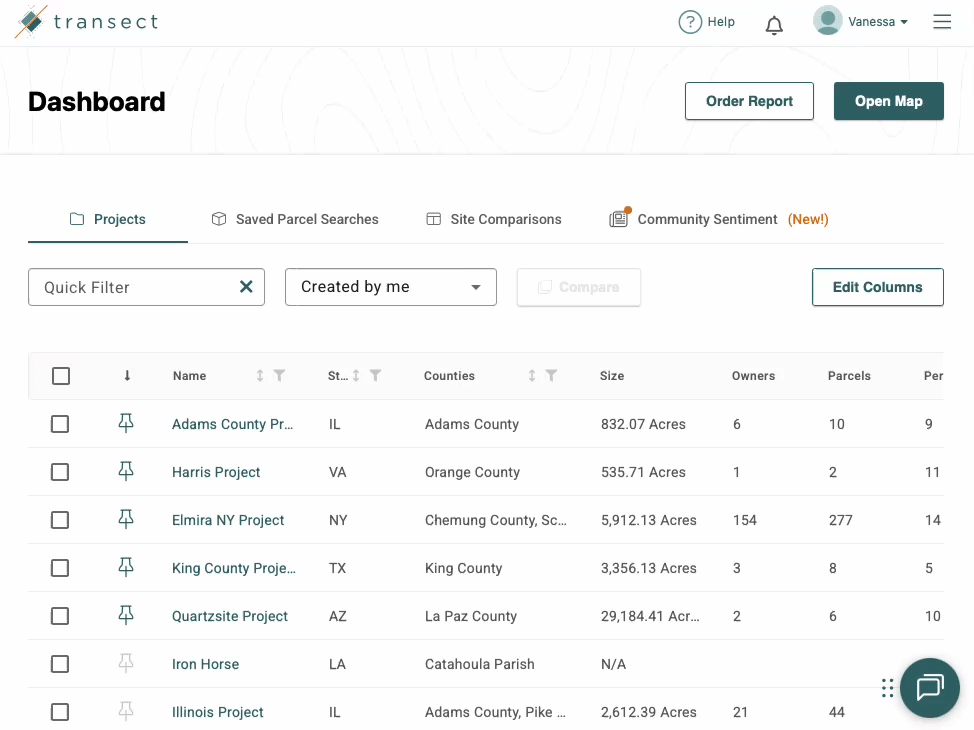Solar, Wind, and Battery Pulse
Assess community sentiment toward renewable projects in seconds.
Solar, Wind, and Battery Pulse are separate products that complement our core offering. For more information on pricing, please contact your Customer Success Manager or email support@transect.com.
Overview
Solar, Wind, and Battery Pulse are AI-driven tools built on a vast proprietary dataset to simplify discovery of public opinion toward renewables development in your project area. By utilizing sentiment scores and data from Pulse, developers can trim hours off their due diligence, avoid costly site selection mistakes, and craft stronger community engagement strategies for their projects.
In this article, we'll review:
- Key Features of Pulse
- Pulse Information in the Map
- Pulse Information in a Report
- Pulse Information in the Dashboard
- Sub-County Pulse
- Frequently Asked Questions
Key Features of Pulse
- Interactive Heatmap: Visualize county and sub-county-level sentiment towards renewable development; pinpoint operating, planned, and canceled or postponed project locations; and quickly identify jurisdictions with moratoriums.
- AI-Driven Sentiment Analysis: Access in-depth analysis of thousands of news articles, petitions, and posts on X or Facebook groups to understand local sentiment towards renewable development.
- Vast Regulations Database: Review hundreds of moratoriums and ordinances with concise summaries and optional Expert Verifications.
- Stakeholder Insights: Gain valuable insights into local stakeholders influencing public sentiment and their primary reasons for opposition (if any).
Pulse Information in the Map
Pulse layers are best viewed by zooming out to 10-20 miles for county level scores, or 2 miles for sub-county scores. You can check your zoom in the lower-left corner of Transect: ![]()
Within the Map, you can view Pulse information by enabling the relevant layers and selecting jurisdictions of interest on the Map to surface the pop-out. Here are all the ways you can view Pulse information in the map:
- Map Layers: Select the corresponding checkboxes to enable or disable the following Pulse layers:

- Heatmap: Identifies county and sub-county jurisdictions with positive, negative, or mixed sentiment. Click the Heatmap for jurisdictions of interest to view all the Pulse data driving each jurisdiction's overall Pulse score.

Jurisdictions with an “unsure” label/coloring are those for which we currently lack data, either because there’s been zero solar/wind/battery development activity in these jurisdictions, or the relevant data is not yet digitally available. If you come across any jurisdictions during your own due diligence where we’re missing data that you’ve found yourself through other sources, please tell us via the in-app feedback mechanism by giving us a thumbs-down with a brief note describing the data you found, where you found it, and ideally, a relevant link. This helps to accelerate the improvement process of the Pulse tools. - Projects: Locates operating (green), planned (blue), and canceled or postponed (red) projects. Hover over project pins to see their names, or select them to view all the info in the popup modal, as provided by the latest monthly 860M report from EIA. Be sure to scroll the table to the right to see all data.

Map layer names for this project data will appear as Solar Farms, Wind Farms, and Battery Projects, for Solar Pulse, Wind Pulse, and Battery Pulse, respectively.
- Moratoriums: Pinpoints jurisdictions with likely solar, wind, or battery development restrictions. Click a moratorium icon to quickly view its one-paragraph summary and access the original source doc.

- Pop-Out Modal: As described above, click any county or sub-county jurisdiction in the Heatmap layer to view the underlying data (sentiment, velocity/activity, and regulations) driving the jurisdiction’s score. The “Stakeholders” tab provides an organized list of key people and organizations influencing local sentiment.

- “Your Site Selection” Side Modal: Create a project area in the Map to showcase Pulse scores for relevant jurisdiction(s) in the side modal.

Pulse Views in Reports
At the top of the Executive Summary, you’ll see a Pulse card that indicates the overall sentiment rating of the jurisdiction(s) where your AOI is located.
Next to the county or sub-county's name, you’ll see color-coded iconography that indicates whether the rating is positive (green), mixed (orange), negative (red), or unsure (gray). You can click the icons to be routed to other sub-pages:
 AI Sentiment: The Sentiment tab highlights the aggregated sentiment score within each of your project area’s jurisdiction(s), with a list of the news articles and their individual sentiment scores, sources, brief summaries, score reasoning, and links. You'll also see tabs for Petitions and Social Media, which provide a broader take on what opposition may be like in your area of interest. The Stakeholders and Opposition Points tabs provide valuable insights about the local people or organizations influencing public sentiment and their primary reasons for opposition, if any.
AI Sentiment: The Sentiment tab highlights the aggregated sentiment score within each of your project area’s jurisdiction(s), with a list of the news articles and their individual sentiment scores, sources, brief summaries, score reasoning, and links. You'll also see tabs for Petitions and Social Media, which provide a broader take on what opposition may be like in your area of interest. The Stakeholders and Opposition Points tabs provide valuable insights about the local people or organizations influencing public sentiment and their primary reasons for opposition, if any.
Please note that AI Solar Sentiment only tracks new articles relevant to utility-scale and community solar projects. News about rooftop solar is not included. And AI Wind Sentiment focuses on utility-scale, onshore wind projects.

 Solar Velocity / Wind Activity / Battery Activity: This report sub-page provides a list of projects in various stages of development, including operating, planned, and canceled or postponed, within the jurisdiction(s) where your project is located. This data is sourced directly from the U.S. Energy Information Administration (EIA), with updates occurring on a monthly basis.
Solar Velocity / Wind Activity / Battery Activity: This report sub-page provides a list of projects in various stages of development, including operating, planned, and canceled or postponed, within the jurisdiction(s) where your project is located. This data is sourced directly from the U.S. Energy Information Administration (EIA), with updates occurring on a monthly basis.
You can sort or filter the projects by a few key data fields, like Nameplate Capacity, Planned Operation Year, etc. This section of Pulse also includes data for projects that have directly experienced significant opposition at the local or state level. Click the Contested Projects tab to see these for a given jurisdiction (if it has any), and then click the View button under “Description” to see a summary of what happened, along with links to relevant sources.
 Regulations: On this report sub-page, you’ll find a list of any moratoriums or ordinances we’ve collected for the jurisdiction(s) where your project is located. You’ll see summaries of these regulations, links to the source docs, and an option for “Expert Verifications” of moratoriums, for no added fee.
Regulations: On this report sub-page, you’ll find a list of any moratoriums or ordinances we’ve collected for the jurisdiction(s) where your project is located. You’ll see summaries of these regulations, links to the source docs, and an option for “Expert Verifications” of moratoriums, for no added fee.
Please note that Pulse data is not yet included in PDF exports, but will be soon.
Pulse Information in the Dashboard
From the Dashboard, you'll select Community Sentiment to view news articles about renewables wherever you've run reports. This page will provide a list of articles that you can filter by Type (Solar, Wind, Battery), State, or Jurisdiction. On this page, you'll also notice that:
- Articles are presented in reverse-chronological order.
- Articles are related to solar, wind, and battery storage development, regardless of how many Pulse products you subscribe to (or none at all).
- If your organization doesn't subscribe to either Solar Pulse. Wind Pulse, or Battery Pulse, you'll see at most 10 articles. Otherwise there is no limit on how many articles may appear.

Sub-County Pulse (New!)
Sub-County Pulse scores can be viewed in the Heatmap by zooming in beyond the county level boundaries. We recommend a zoom of 2 miles, which is shown on the lower-left corner of Transect’s map: ![]()
In many states, sub-county jurisdictions establish their own regulations for renewable energy projects. This drove us to improve the granularity of our Pulse offering, by allowing users to “zoom to” sentiment data at the city and town level, while also maintaining visibility of the Pulse data and scores at the county level.
You can view sub-county data by zooming in on the Heatmap layer past a county to identify specific cities, towns, townships, or villages, as shown below:
Frequently Asked Questions
- Where does your AI Solar / Wind / Battery Sentiment (news article) data and analysis come from?
We’ve built a proprietary data collection and analysis process to specifically target news articles that mention solar, wind, or battery energy development. - Where does your Solar Velocity / Wind Activity / Battery Activity (solar / wind / battery projects) data come from?
We’re pulling most of this data directly from the U.S. Energy Information Administration (EIA), with updates occurring on a monthly basis. Our contested project data comes from our friends at the Sabin Center via their June 2024 report. - How does your “Under Development” project data differ from the rest of the Solar Velocity data?
*(only relevant to Solar Pulse; not Wind or Battery Pulse)
While EIA project data is generally regarded as the most accurate and comprehensive dataset available for operating solar projects, it only has about 1,000 projects nationwide in the “planned” stage (as of April 2025). To provide a more comprehensive view of projects likely to still be under development, we’re supplementing EIA data in Solar Velocity with data on over 12,000 projects that were “under development,” according to a data provider called Ohm Analytics, as of July 2024. This data may have some inaccuracies, so it isn’t factored into Solar Pulse scores, nor are these projects represented on the map.
Projects in this "Under Development" stage had generally either applied for interconnection, had a zoning hearing, were still in the construction phase, and/or had yet to generate electricity, as of July 2024. - Where does your Solar / Wind / Battery Regulations (moratoriums and ordinances) data come from?
We’ve built a proprietary data collection and analysis process. - How often do you refresh your Pulse data?
We refresh our AI Sentiment data weekly, project data monthly, and regulations data monthly. - How are you calculating a given jurisdiction’s overall Solar / Wind / Battery Pulse score?
We’ve built a proprietary algorithm based on the three sub-scores listed below. Each has a different weighting to create an aggregated Pulse score for every jurisdiction in the U.S. If there is no data for news, projects, or regulations in a given jurisdiction, then the aggregated score will be “Unsure.” - How are you calculating a given jurisdiction’s AI Solar / Wind / Battery Sentiment score?
We analyze individual news articles to determine how the content and tone seem to be toward solar, wind, or battery development, ultimately leading to a positive, negative, or neutral score. The articles written most recently are assigned a greater weight. Next, all news articles’ scores for a given jurisdiction are combined to gauge the overall implied sentiment toward solar, wind, or battery development, which determines the AI Solar / Wind / Battery Sentiment score. If there is no data for solar / wind / battery news in a given jurisdiction, then the AI Solar / Wind / Battery Sentiment score will be “Unsure.” - How are you calculating a given jurisdiction’s Solar Velocity / Wind Activity / Battery Activity score?
Jurisdictions with operating and/or planned projects, but no contested projects, will receive a positive score. The score is weighted higher (more positive) for jurisdictions with recently operational projects. Jurisdictions with only contested projects (no operating or planned projects) will have a negative score, and scores for jurisdictions with both operating / planned and contested projects will depend upon the relative counts of projects in these categories. - How are you calculating a given jurisdiction’s Solar / Wind / Battery Regulations score?
If there’s at least 1 moratorium (regardless of the presence/number of ordinances), then the score will be “Negative.” If there’s at least 1 ordinance but no moratoriums, then the score will be “Positive."
NOTE: Some ordinances can be negative for solar, wind, or battery development, though this generally depends on the details and/or location of a project. When all things are equal between two jurisdictions re: solar, wind, or battery sentiment but one jurisdiction has an ordinance and the other doesn’t, we assume that the jurisdiction with the ordinance would be a safer bet for new development, as they’ve started thinking about how they’ll manage solar, wind, or battery development (whereas the other jurisdiction is more of a wildcard and may enact a moratorium while they wrap their heads around renewables).
If there are zero ordinances or moratoriums, then the Solar / Wind / Battery Regulations score will be “Unsure." - Do you have any data about when developers took leases for their projects?
No, we currently don't track when developers took leases for their projects. - How can I share Pulse information with my team?
Pulse information can be shared with your team by sharing the report via magic link. Users will be able to review and interact with a read-only version of the Executive Summary and Pulse data. - How are you defining the opposition points within AI Solar / Wind / Battery Sentiment?
|
Reason |
Description |
|
Other |
Opposition for reasons not listed below, often specific to individual circumstances or broader concerns. |
|
Lack of Community Input |
Lack of meaningful consultation or involvement of the local community in the decision-making process. |
|
Failure to Respect Tribal Rights |
Objections due to the potential infringement on indigenous land rights and lack of consultation with Tribal authorities. |
|
Land Value Impacts |
Concerns that the project will decrease property values in the surrounding areas. |
|
Health and Safety |
Concerns about health risks associated with the project, including radiation from solar panels or accidents during construction. |
|
Mistrust of Corporations |
Distrust towards the associated organization, including their motives and transparency. |
|
Aesthetic Concerns |
Concerns that the project will be visually unappealing, especially with long stretches of chain-linked fence. |
|
Construction Impacts |
Objections due to noise, pollution, and dust from construction vehicles. |
|
Loss of Agriculture |
Concerns about changing the community’s farming character. |
|
Environmental Concerns |
Potential negative impact on local ecosystems, wildlife, and natural habitats. |
- How are you defining the stakeholder types within AI Solar / Wind / Battery Sentiment?
|
Name |
Description |
|
Business |
A registered business entity involved in the project. |
|
Influencer |
A third party engaged by Developers or Groups to influence the community's perspective on the project, such as a researcher from a local university speaking at a town hall on the merits of solar projects. |
|
Group |
A for-profit, non-profit, or other organized entity that holds an opinion, favorable or not, about the proposed project. This may include organizations such as an Alliance, Institute, or Association. |
|
Citizen |
A resident or non-resident, other than the Landowner, who resides in the town, city, municipality, or county and holds an opinion, favorable or not, about the proposed project. |
|
Landowner |
An owner of the land where the proposed project would be constructed. |
|
Official |
An elected or appointed government representative at a town, city, municipality, or county level, such as a Mayor, or a Member of a Board, Commission, or City Council. |
|
Community Affairs |
A person responsible for Community Affairs, Community Relations, or similar issues, whether employed directly by a project development company or contracted as a consultant. |
|
Developer |
Any individual working at a project development company (e.g., a solar developer). |
- How can I share my feedback or ideas for improving Pulse?
Your feedback is important in helping us enhance Pulse's value in your development efforts. Please use the in-app feedback tool (screenshot below) to provide positive and negative feedback on the helpful features and data and where there’s room for improvement (e.g., missing news articles with links). For general feedback or to help us prioritize which features to build next, please contact your Transect Customer Success Manager, who can set up a time for you to speak with our Product Team.

